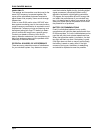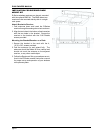
R100 OWNERS MANUAL
page 6
COMPATIBILITY
The receiver and transmitter must be tuned to the
same VHF frequency to operate together. Be-
cause of the specialized equipment required to
adjust these units properly, users cannot change
frequencies.
If two or more R100 and/or other VHF/UHF wire-
less systems are being used in the same location,
proper frequency coordination is required to avoid
interference. Frequency mixing and spacing must
be factored along with local TV stations to deter-
mine if conflicts will result from a specific group.
Contact your dealer or Electro-Voice for fre-
quency-selection assistance if you are planning to
add more wireless systems to be operated simul-
taneously in the same location.
POTENTIAL SOURCES OF INTERFERENCE
There are many potential sources of interference
for your wireless system. Any electronic compo-
nent that contains digital circuitry including digital
signal processors (reverb/multi-effects units),
electronic keyboards, digital lighting controllers,
CD players and computers all emit rf energy that
can affect the performance of your wireless sys-
tem. It is always best to place your receiver as far
away from these devices as possible to minimize
the potential for of problems.
BATTERY RECOMMENDATIONS
Fresh 9-volt alkaline batteries from a quality
manufacturer will yield the best performance from
R100 transmitters. 8.4-volt ni-cad batteries can be
used but will yield much shorter operational time.
When the transmitter switch is turned on, the bat-
tery light will flash one time if the battery is good.
If the light does not flash or stays lit continuously,
the battery is weak or nearly dead. If the light
comes on during use, the battery is weakening
and should be replaced as soon as possible.














